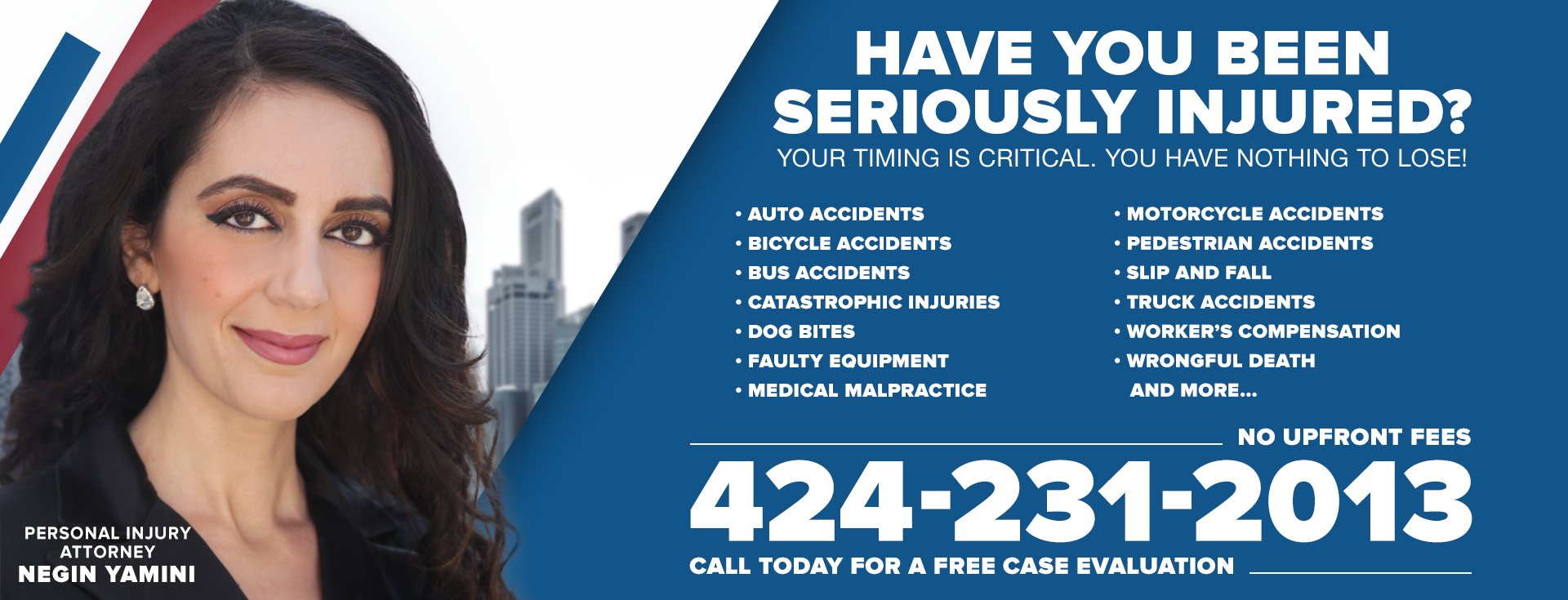Each year, the Centers for Disease Control and Prevention (CDC) reports over 800,000 hospitalizations due to fall-related injuries, with staircase falls being a leading cause. Also, in 2018, the American Journal of Emergency Medicine published a 23-year study showing that about one million Americans sustain injuries from staircase falls annually, and emergency medical response handles 60% of these cases.
Injury severity varies, with some people sustaining minor bruises while others suffer broken bones, head trauma, or spinal cord damage. Sometimes, severe stair accidents result in permanent disability or death. The California justice system offers legal avenues to injury victims who sustain their injuries due to negligent, unsafe stair conditions.
A personal injury attorney can help investigate the incident, identify responsible parties, and pursue damages like medical bills, lost income, and pain and suffering. This article explores 10 common minor and major injuries caused by falling down stairs.
Common Minor Injuries from Stairway Falls
Injuries you sustain from stair-related falls require medical attention; however, some might not be fatal. Below are minor injuries you sustain after falling down stairs:
- Sprains and Strains
When you slip on the stairs, your body can experience unnatural twisting motions. Your natural reflex to protect yourself by reaching your arms could severely damage your joints and muscles. Many stair-related falls result in sprains and strains, which cause pain and swelling in your body. As a result, the pain limits your range of motion.
Ligaments that connect your joints suffer tears or complete ruptures when they extend past their natural limits during a sprain. The impact of an awkward knee or ankle landing stretches these ligaments, resulting in intense pain and joint instability. Sprains commonly affect ankles due to their twisting motion under pressure. Additionally, knee ligaments are damaged, resulting in painful difficulty walking.
Usually, a strain targets both muscles and tendons in the body. The muscles across your body, including arms, legs, and back, may experience overstretching or tearing when you grab for support or tense your body before impact. The injuries from strains cause muscle soreness and stiffness, which might persist from days to weeks.
The R.I.C.E. (rest, ice, compression, and elevation) method is effective for mild sprains and strains, but more serious cases require medical care. The failure to treat sprains or strains results in extended instability or chronic pain, transforming minor injuries into ongoing problems.
-
Soft Tissue Injuries
Soft tissue injuries affecting muscles, tendons, and ligaments from stair accidents cause severe discomfort, swelling, and reduced mobility. Examples of injuries are:
-
Whiplash
The neck injury known as whiplash is a soft tissue injury that develops when the neck snaps forward and backward during a fall down stairs. Also, a fall that results in head contact or powerful impact can lead to whiplash. Your neck's muscles and ligaments become strained when you move quickly. You might experience stiffness, headaches, and dizziness.
-
Muscle And Ligament Bruising
Muscle bruising and ligament damage occur when you strike steps or hard surfaces during high-impact falls. Deep muscle contusions result in swelling and pain that take weeks to heal, although the initial bruising symptoms seem minor. Severe tears in ligaments of the knees and shoulders result in stability issues that sometimes need surgery.
-
Lacerations and Contusions
The impact from stairway falls causes lacerations (cuts) and contusions (bruises) as direct impact injuries. You sustain injuries like surface abrasions and deep tissue damage from hitting sharp edges, hard surfaces, and rough textures. Lacerations and contusions cause you pain and leave permanent scars. They might also cause medical complications that require medical treatment.
The severity of lacerations ranges from shallow, superficial cuts to deep wounds that require stitches. A fall on sharp or jagged stair edges causes deep gashes that could cause infections if you do not seek medical care. Minor wounds can become dangerous if they develop on body sections with high movement, like your hands, knees, and face.
Blunt force trauma ruptures blood vessels beneath the skin to cause contusions, also known as bruises. You will likely sustain bruises on arms, legs, and back areas during stair-related falls because these body parts strike against steps or floor surfaces. Deep tissue contusions cause persistent pain and stiffness, affecting patients after naturally healing bruises.
Serious Injuries from Stairway Falls
A single misstep on a staircase can generate enough force to break bones, damage vital organs, and cause permanent neurological damage. Severe injuries victims sustain during stairway accidents include the following:
-
Fractures and Broken Bones
A fall down stairs delivers extreme physical pressure to the body, resulting in bone fractures and broken bones. Multiple body impacts occur during stair-related falls because the body strikes steps and railings and hits the floor below.
The extent of bone fractures depends on multiple elements, including:
- The vertical distance of your drop
- The direction of body contact
- The strength of your bones
Elderly individuals, especially those with osteoporosis, are at higher risk of multiple fractures that may require surgery.
While bones are strong, they cannot withstand some stairway falls. The human body automatically prepares itself for contact after losing balance or tripping on stairs. During the fall, the body tends to develop fractures in weight-bearing and impact-absorbing areas like legs, arms, and ribs.
-
Legs and Ankles
Stair-related falls most commonly lead to fractures in the legs and ankles. You risk unnatural leg twisting while falling, which results in broken tibias, fibulas, or ankle fractures. Also, you may break these bones by landing directly on them. Fractures could cause swelling, intense pain, and the inability to carry weight.
-
Arms and Hands
The arms and hands are at high risk for fractures because people instinctively stretch out their hands to protect themselves during falls. Wrist fractures, known as Colles’ fractures, broken fingers, and forearm fractures, occur due to this reflex.
Displaced fractures occur when the impact forces a broken bone to shift from its proper position, thus requiring surgical correction or realignment.
-
Ribs
A fall onto stairs or a collision with the railing leads to rib fractures that cause severe pain during every inhalation. Rib fractures are dangerous because they create the risk of organ puncturing, which causes fatal conditions, including collapsed lungs and internal bleeding.
The recovery process requires pain management and movement restrictions for most patients, though severe cases need hospitalization and ongoing medical observation.
-
Head Injuries
Falling down stairs could cause severe head and neck injuries. A blow to the head against steps, railings, or hard surfaces can produce both mild concussion and severe traumatic brain injuries (TBIs). Neck injuries can result in nerve damage, chronic pain, and paralysis in extreme cases.
-
Concussions
A concussion develops when rapid brain motion happens inside the skull following sudden impact. A concussion occurs even without an external wound. Its symptoms include:
- Dizziness
- Confusion
- Nausea
- Headaches
- Memory impairment
Some concussion victims experience brief unconsciousness, and others develop worsening symptoms that appear after the initial injury. Medical care must be sought whenever someone experiences confusion that continues along with slurred speech and light sensitivity after a fall. Postponing concussion treatment increases the danger of permanent cognitive damage or post-concussion syndrome.
-
Traumatic Brain Injuries (TBIs)
A traumatic brain injury (TBI) is the most dangerous injury that stair-related accidents can cause to you. A TBI develops when head trauma interrupts regular brain functioning, which can cause lasting disabilities, including speech problems, motor skill disruption, and permanent disability.
The severity of TBI determines its classification based on the level of brain damage. People who suffer from mild TBIs experience brief confusion along with headaches. Severe TBI victims develop brain bleeding that leads to permanent neurological damage. The recovery process for some victims extends to long-term rehabilitation because brain injuries cause cognitive decline together with emotional instability and impaired coordination.
-
Skull Fractures and Facial Injuries
A direct blow to the head can result in skull fractures with different severity levels that may either be minor or severe breaks that expose brain tissue. A skull fracture has symptoms such as intense headaches and fluid drainage through the nose or ears, together with eye bruising and unconsciousness.
People who fall on stairs commonly sustain facial injuries when their faces strike either steps or railings. The permanent disfigurement, eating, and speaking difficulties result from broken noses together with fractured cheekbones and jaw injuries. Reconstructive surgery could restore normal function and appearance in particular situations.
-
Spinal Cord and Back Injuries
A stair-related tumble creates excessive stress on your spinal cord and back, which results in injuries ranging from temporary pain to permanent disability. Your backbone consists of bones, nerves, and soft tissues. These support your body structure and allow movement.
-
Paralysis
The severity of nerve damage, along with functional loss, determines how spinal cord injuries (SCIs) are classified. A complete SCI causes complete sensory and motor loss beneath the injury area, whereas an incomplete SCI preserves some sensory and motor functions. The most severe consequences of stair-related falls result in paraplegia, which means complete lower body paralysis, or quadriplegia, which means full paralysis of all four limbs.
Nerve impingement and pinched nerves, which are milder spinal injuries, cause radiating pain, muscle weakness, and numbness as their symptoms. The injuries victims sustain result in persistent back pain, walking problems, and reduced movement range. These demand time-consuming physical therapy sessions, pain management interventions, and surgical procedures.
-
Herniated Discs and Vertebral Fractures
A back-related fall that results in twisting or compression of the spine will cause a herniated disc, also called a slipped or ruptured disc. A herniated spinal disc becomes painful when the tear presses against nearby nerves, producing sharp pain, tingling sensations, and loss of strength in the arms or legs.
Severe stairway falls can cause vertebral fractures, breaking spinal bones under extreme pressure. The different types of spinal fractures include compression fractures that cause pain and hunched posture, as well as burst fractures that cause spinal instability and possible paralysis.
-
Mobility Issues, Chronic Pain
Spinal injuries impact how you perform your everyday activities. You experience restricted mobility and persistent pain that decreases your quality of life. You might need mobility devices such as canes and wheelchairs if you face ongoing pain that hinders your daily activities and movements.
Spinal injuries cause significant emotional and financial strains on victims beyond their physical limitations. The medical expenses, rehabilitation costs, and lost income cause overwhelming financial challenges.
With the help of a personal injury attorney for compensation, early medical treatment and legal action can cover medical expenses, lost income, and extended medical care.
-
Knee Injuries
Your knees are a major target of impact during stair-related falls. Knee injuries occur when you directly hit the knees or move improperly during balance recovery attempts. Because the knee is a complex joint structure, any injury can cause substantial mobility problems.
-
Torn Ligaments and Cartilage Damage
The knee maintains stability through three key ligaments, including:
- An anterior cruciate ligament (ACL)
- Medial collateral ligament (MCL)
- Posterior cruciate ligament (PCL)
The ligaments experience stretching or tearing when someone falls down stairs, causing swelling, instability, and significant pain.
A torn ACL is one of the gravest knee injuries because patients need surgery followed by prolonged physical therapy.
Cartilage damage that includes a torn meniscus will cause your joints to become stiff, while also causing them to lock up and creating problems with weight bearing. Knee ligament injuries that become severe will result in permanent disabilities that limit your ability to walk and climb stairs, and stand without resting for long periods.
-
Knee Dislocations and Fractures
A dislocated knee develops when the bones that compose the joint move away from their normal position between the femur, tibia, and patella. The knee experiences violent twisting motions or strikes hard surfaces such as stair edges, leading to these injuries. Emergency medical care might be necessary to treat dislocation injuries that damage knee ligaments, nerves, and blood vessels because they could lead to leg circulation problems.
The knee sustains patellar (kneecap) fractures and other knee injuries as a result of stair-related falls. A fractured kneecap prevents you from straightening your leg or bearing weight on it, which leads to surgical treatment and long-term recovery with immobilization. The recovery process includes bracing combined with physical therapy and might require either partial or total knee replacement surgery.
-
Nerve Damage
Another severe yet neglected injury from stairway falls is nerve damage. Nerve injuries show full symptoms only after days or weeks following an accident because their immediate impact is hidden from view.
Nerve injuries from stair falls happen when pressure, stretching, or complete severing of nerves result in different levels of nerve dysfunction. A spinal cord injury often leads to nerve damage because of its location. The injury severity determines whether the damage results in partial or complete paralysis. The pressure from injuries to vertebrae, discs, or surrounding tissues can develop into conditions such as sciatica or neuropathy regardless of spinal cord damage.
A direct impact to limbs, shoulders, or hips can cause peripheral nerve damage when such blows compress or sever nerves. A hard elbow or wrist impact during a fall can harm the ulnar or radial nerves, producing hand and finger numbness, weakness, and diminished sensation.
-
Hip Injuries
Among the most serious injuries from stairway falls affecting mainly older adults are hip injuries. The hip's functions are stability, movement, and weight-bearing. An injury to this area results in significant life changes. Elderly people who have osteoporosis face a high risk of severe hip fractures that need surgical procedures and lengthy recovery times because of their age and condition.
An older person's impact from a stairwell fall can break their femoral neck, intertrochanteric region, or acetabulum (hip socket). Older people experience reduced bone density, which weakens their hip joints, increasing their chances of fracturing after minor falls.
A year following a hip fracture leads to the death of 20–30% of older adults because of infections linked to blood clots and limited mobility, which triggers additional health complications. A substantial number of elderly patients fail to recover their independence after such injuries and need ongoing nursing care or assistance with mobility.
Severe hip injuries require surgery as the primary medical solution for treatment. The necessary surgical procedure depends on the size and placement of the fracture. Doctors choose between hip pinning and partial hip replacement (hemiarthroplasty) or total hip replacement when treating patients to restore function and minimize pain. After hip surgery, the recovery process becomes extensive and difficult because patients need extensive physical therapy combined with pain management and help for their everyday activities.
-
Neck Injuries
Falling down stairs can cause neck injuries ranging from muscle strains to severe spinal damage. Whiplash occurs when the neck jerks suddenly, straining soft tissues and causing stiffness, headaches, and dizziness. While mild cases heal with rest, severe cases may require therapy.
A cervical spine fracture results from direct impact, leading to intense pain, swelling, and potential paralysis. These fractures often require surgery, immobilization, and long-term rehabilitation. Falls can also cause pinched nerves or herniated discs, leading to radiating pain, numbness, and weakness in the arms and shoulders.
Neck injuries may result in chronic pain, reduced mobility, and long-term disabilities. If hazardous conditions, such as broken handrails or poor lighting, caused your fall, you may be entitled to compensation. A personal injury attorney can help you prove liability and seek damages for medical expenses, lost wages, and suffering.
Find a Los Angeles Personal Injury Lawyer Near Me
A staircase fall’s outcome could be a minor skin bruise or a serious injury that impacts your physical capabilities, health status, and monetary stability. After sustaining any kind of fracture, spinal injury, or brain trauma, you need immediate medical attention. Your situation will become worse while your legal case strength decreases when you postpone receiving medical care for hidden injuries.
Your apparent minor injuries could mask dangerous conditions such as concussions and internal bleeding that might emerge later. Medical attention right after an incident provides accurate diagnosis and treatment while establishing medical records that might be needed for legal processes.
Negligence causing your fall might entitle you to receive compensation. The Los Angeles Personal Injury Attorney team provides free consultation and services for premises liability cases. You can reach our qualified personal injury lawyers at 424-231-2013. We will represent you to fight for your deserved compensation as you focus on recuperating at home.
























